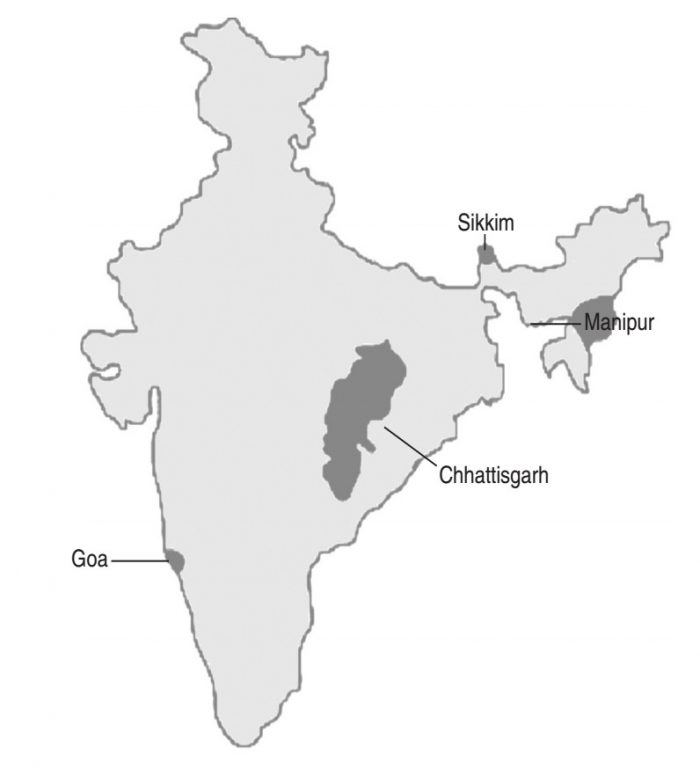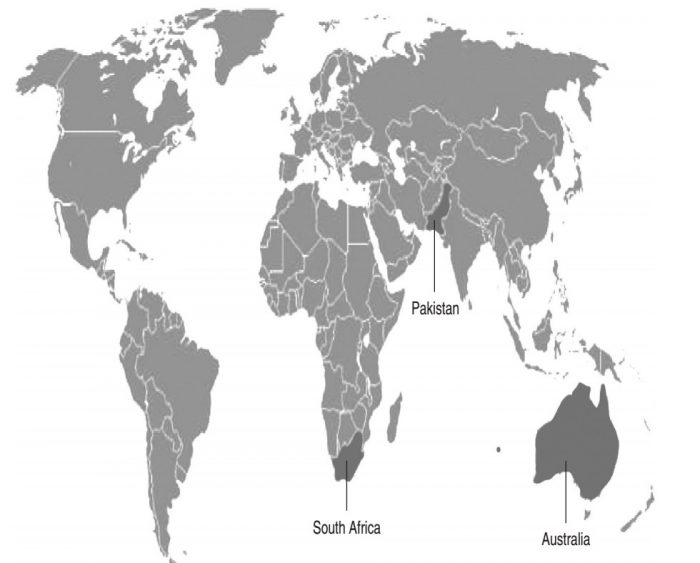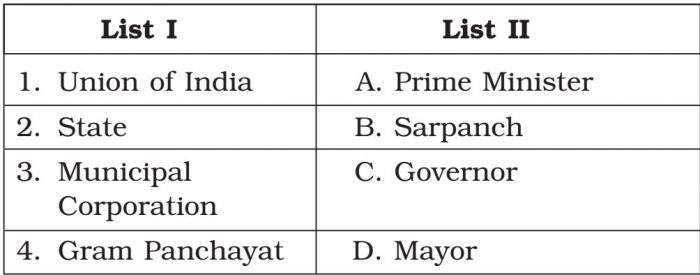Question 1. Locate the following states on a blank outline political map of India: Manipur, Sikkim, Chhattisgarh and Goa.
Answer 1

Question 2. Identify and shade three federal countries (other than India) on a blank outline political map of the world.
Answer 2

Question 3. Point out one feature in the practice of federalism in India that is similar to and one feature that is different from that of Belgium.
Answer 3 . In India, just like in Belgium, the central government has to share its powers with the regional governments. But unlike India, Belgium has a community government in addition to the central and the state governments.
Question 4. What is the main difference between a federal form of government and a unitary one? Explain with an example.
Answer 4
| Federal Government | Unitary Government |
| In a federal form of government, the central government shares its powers with the various constituent units of the country. | In unitary form of government either there is only one level of government or the sub-units are subordinate to the central government. |
| In a federal system, the central government can not order the state government to do something.State government has powers of its own for which it is not answerable to the central government. | The central government can pass on orders to the provincial or the local government. |
| For Ex : India, USA, Canada | For Ex: UK, China, france |
Question 5. State any two differences between the local government before and after the Constitutional amendment in 1992.
Answer 5
| Local governments before the Constitutional amendment in 1992 | Local governments after the Constitutional amendment in 1992 |
| Elections were not held regularly. | It is constitutionally mandatory to hold regular elections to local government bodies. |
| Local governments did not have any power or resources of their own. | The State governments are required to share some powers and revenue with local government bodies. |
Question 6. Fill in the blanks:
Since the United States is a (a) ……… type of federation, all the constituent states have equal powers and states are (b) ……… vis-à-vis the federal government. But India is a (c) ……… type of federation and some states have more power than others. In India, the (d) ………. government has more powers.
Answer 6 (a) coming together (b) strong (c) ‘holding together’ (d) Central.
Question 7. Here are three reactions to the language policy followed in India. Give an argument and an example to support any of these positions.
Sangeeta: The policy of accommodation has strengthened national unity.
Arman: Language-based States have divided us by making everyone conscious of their language.
Harish: This policy has only helped to consolidate the dominance of English over all other languages.
Answer 7 . Sangeeta’s reaction is the best. Unlike Sri Lanka (where the language of the majority has been promoted), the Indian polity has given equality of status to all the major languages spoken in the country. This has eliminated the chance of social conflict on linguistic basis. The policy of accommodation has made administration easier. It has also ensured a larger participation in the government’s activities by people who speak various languages.
Question 8. The distinguishing feature of a federal government is:
(i) National government gives some powers to the provincial governments.
(ii) Power is distributed among the legislature, executive and judiciary.
(iii) Elected officials exercise supreme power in the government.
(iv) Governmental power is divided between different levels of government.
Answer 8 (iv) Governmental power is divided between different levels of government.
Question 9. A few subjects in various Lists of the Indian Constitution are given here. Group them under the Union, State and Concurrent Lists as provided in the table below.
A. Defence B. Police
C. Agriculture D. Education
E. Banking F. Forests
G. Communications H. Trade
I. Marriages
| Union List | |
| State List | |
| Concurrent List |
Answer 9
Union List : Defence, Banking, Communications
State List : Police, Agriculture, Trade
Concurrent List : Education, Forests, Marriages
Question 10. Examine the following pairs that give the level of government in India and the powers of the government at that level to make laws on the subjects mentioned against each. Which of the following pairs is not correctly matched?
1. State government (a) State List
2. Central government (b) Union List
3. Central and State (c) Concurrent List governments
4. Local governments (d) Residuary powers
Answer 10 4) Local governments (d) Residuary powers
Question 11. Match List I with List II and select the correct answer using the codes given below the lists:


Answer 11 (c) A C D B
Question 12. Consider the following statements:
A. In a federation the powers of the federal and provincial governments are clearly demarcated.
B. India is a federation because the powers of the Union and State Governments are specified in the Constitution and they have exclusive jurisdiction on their respective subjects.
C. Sri Lanka is a federation because the country is divided into provinces.
D. India is no longer a federation because some powers of the states have been devolved to the local government bodies.
Which of the statements given above are correct?
(a) A, B and C
(b) A, C and D (c) A and B only
(d) B and C only
Answer 12 (c) A and B only